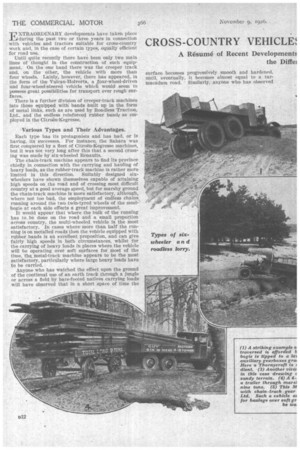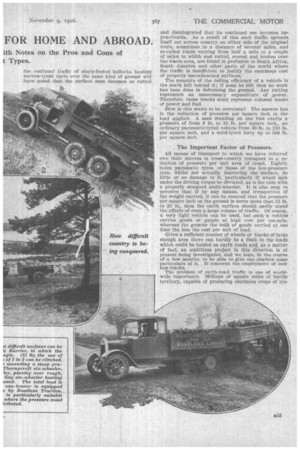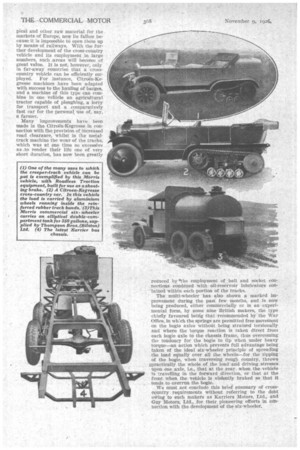CROSS-COUNTRY VEHICLE! FOR HOME AND ABROAD.
Page 102

Page 103

Page 104

If you've noticed an error in this article please click here to report it so we can fix it.
A Resume' of Recent Development the Diffel
ith Notes on the Pros and Cons of t Types.
EXTRAORDINARY developments have taken place during the past two or three years in connection with vehicles and tractors suitable for cross-country work and, in the case of certain types, equally efficient for road use. Until quite recently there have been only two main lines of thought in the construction of such equipment. On the one hand there was the creeper track and, on the other, the vehicle with more than four wheels. Lately, however, there has appeared, in the form of the Vulcan-Holverta, a four-wheel-driven and four-wheel-steered vehicle which would seem to possess great possibilities for transport over rough surfaces. There is a further division of creeper-track machines into those equipped with' bands built up in the form of metal links, such as are used by Roadless Traction, Ltd., and the endless reinforced rubber bandy as employed in the Citroend.Cegresse.
'Various Types and Their Advantages.
Each type has its protagonists and has had, or is having, •its successes. For instance, the Sahara was first conquered by a fleet of Citroen-Kegresse machines, but it was not very long after this that a second cross ing was made by six-wheeled Renaults. . The chain-track machine appears to End its province chiefly in connection with the carrying and hauling of heavy loads, as the rubber-track machine is rather more limited in this direction. Suitably designed sixwheelers have shown themselves capable of attaining high speeds on the road and of crossing most difficult country at a good average speed, but for marshy ground the chain-track machine is more satisfactory, although, where not too bad, the employment of endless chains running around the two twin-tyred wheels of the semibogie at each side effects a great improvement. It would appear that where the bulk of the running has to be done on the road and a small proportion across country, the multi-wheeled vehicle is the most satisfactory. In cases where more than half the running is on metalled roads then the vehicle equipped with rubber bands is an excellent proposition, and can give fairly high speeds in both circumstances, whilst for the carrying of heavy loads in places where the vehicle will be operating over soft surfaces for most of the time, the metal-track machine appears to be the most satisfactory, particularly where large heavy loads have to be carried. Anyone who has watched the effect upon the ground of the continual use of an earth track through a jungle or across a field by bare-footed natives carrying loads will have observed that in a short space of time the surface becomes progressively smooth and hardened, until, eventually, it becomes almost equal to a tarmacadam road. Similarly, anyone who has observed the continual traffic of sharp-footed bullocks hauling narrow-tyred carts over the same kind of ground will have noted that the surface soon becomes so rutted
and disintegrated that its continued use becomes impracticable. As a result of this such traffic spreads itself out across country on either side of the original route, sometimes to a distance of several miles, and so-called roads varying from half a mile to a couple of Miles in width and rutted, scored and broken over the whole area, are found in profusion in South Africa, South America and other parts of the world where the traffic is insufficient to justify the enormous cost of properly macadamized surfaces. '
The measure of the rolling efficiency of a vehicle is the mark left behind it; if none be left then no work has been done in deforming the ground. Any rutting represents an unnecessary expenditure of power. Therefore, these tracks must represent colossal waste of power and fuel. •
Hew is this waste to be overcome? The answer lies in the reduction of pressure per square inch in the load applied. A man standing on one foot exerts a pressure of from 8 lb, to 10 lb. per square inch., an ordinary pneumatic-tyred vehicle from 50 lb. to 120 lb. per square inch, and a solid-tyred lorry up to 500 lb. per square inch.
The Important Factor of Pressure.
All means of transport to which we have referred owe their success in cross-country transport to a reduction of pressure per unit area of tread. Lightly laden pneumatic tyres, or those of the low-pressure type, whilst not actually improving the surface, do little or no damage to it, particularly, if wheel spin under the driving torque be obviated, as is the case with a properly designed multi-wheeler. It is also easy to perceive that if by any, means, and irrespective of the weight carried, it can be ensured that the pressure per square inch on the ground is never more than 15 lb. to 20 lb., then the earth surface should easily stand the effects of even a large volume of traffic. Of course, a very; light vehicle can be used, but such 'a vehicle carries goods or • people at high cost •per ton-mile, whereas the greater the bulk of goods carried at one time the less the cost per unit of load.
Given a sufficient number of wheels or tracks of large enough area there can hardly be a limit to the loads Which could be hauled on earth roads and, as a matter of fact, an ambitious project in this direction is at present being investigated, and we hope, in the course of a few months, to be able to give our readers some particulars of it. It concerns the employment of endless tracks.
The problem of earth-road traffic is one of worldwide importance. Millions of square miles of fertile territory, capable of producing enormous crops of tro
pical and other raw material for the. markets of Europe, now lie fallow because it is impossible to open them up by means of railWays. With the further development of the cross-country vehicle and its employment in large numbers, such iareas Will become of great value. It is not, however, only in far-away countries that a • crosscountry vehicle can be efficiently employed. For instance, Citreen-Kegresse machines have been adapted with success to the hauling of barges, and a machine of this type can combine in one vehicle an agricultural tractor capable of ploughing, a lorry for transport and a comparatively fast car for the personal use of, say, a farmer.
Many improvements have been made in the Citroen-Kegresse in connection with the provision of increased road clearance, whilst in the metaltrack machine the wear of the tracks, which was at one time so excessive as to render their life one of very short duration, has now been greatly
reduced by 'the employment of ball and socket connections combined with oil-reservoir lubricators contained within each portion of the tracks.
The multi-wheeler has also shown a marked improvement during the past few months, and is now being produced, either commercially or in an experimental form, by some nine British makers, the type chiefly favoured being that recommended by the War Office,. in which the springs are permitted free movement on the bogie axles witliont being strained torsionally and where the torque reaction is taken direct from each bogie axle to the chassis frame, thus overcoming the tendency for the bogie to tip when under heavy torque—an action which prevents full advantage being taken of the ideal six-wheeler principle of spreading the load equally over all the wheels—for the lippiug Of the bogie, when traversing rough country, throws practically the whole of the load and driving stresses upon one axle, i.e., that at the rear. when the vehicle is travelling in the forward direction,or that at the front when the vehicle is -violently braked so that it tends to overrun the bogie.
We must not conclude this brief summary of crosscountry requirements without referring to the debt owing to such makers as Earners Motors, Ltd., and Guy Motors, Ltd., for their pioneering efforts in connection with the development of the six-wheeler.












































































































































































































